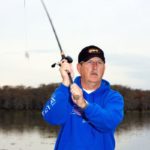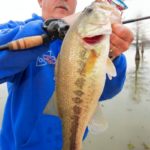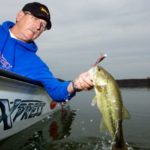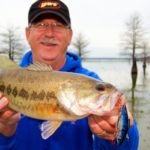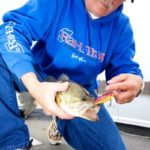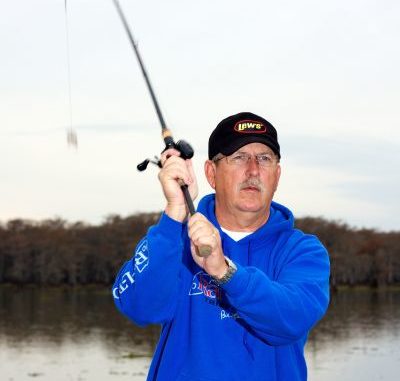
It might be bordering on stupidity to throw a lipless crankbait all day long around Caddo Lake’s grass beds, but it’s the perfect tactic to catch big, wintertime bass.
Lipless crankbaits are not for the cowardly.
With all those exposed treble hooks, the faint-hearted have a hard time seeing past the snag waiting to happen.
On the other hand, the lion-hearted are able to look past potential pain and see the largemouth light at the end of the tunnel.
Therefore, the timid might as well find someplace else to fish during February rather than head to Caddo Lake.
It takes a certain amount of bravado to bass fish a lake full of cypress trees, hydrilla, stumps and salvinia with baits that have six unprotected, dangling hooks.
As a matter of fact, many anglers who do not fish lipless crankbaits at Caddo believe there is more stupidity than swagger associated with slinging these baits all day long.
But that is exactly what Simsboro based tournament angler Sid Havard does: He throws Rat-L-Traps all day long at Caddo Lake during February.
This one-time self-professed pitcher and flipper realized four years ago that he needed to expand his fishing patterns at his favorite wintertime lake.
“I saw these guys out on the flats slinging Rat-L-Traps all day long during tournaments, and I finally got tired of them beating me,” Havard said.
Figuring he should join them if he couldn’t beat them, Havard enlisted the help of one of the better lipless crankbait fishermen at Caddo.
“Kudos go to Danny DuPont,” Havard said. “I asked him how to do it, and he told me — but I still couldn’t figure it out. He met me at Cool Point one morning. We went right out to Big Green Brake, and he showed me how to do it.”
The most important thing Havard learned that day was that grass was the main factor in throwing lipless crankbaits at Caddo.
“If you’re going to catch them really good on a Trap, you need grass,” Havard pointed out. “There wasn’t a whole lot of grass last year. It was only in very few spots; if you found those spots, you caught Trap bass.”
Just last year, Havard and his brother caught 13 bass over 7 pounds. Their best day was five fish that bumped 30 pounds. In a three-fish tournament, they had 18 pounds. And Havard’s personal best was a 9.6-pound bass.
“All on the Trap,” Havard said. “And all between January and March.”
In fact, Havard, who acknowledged that the Trap bite can work all year long, has discovered that big bass bite his Trap best when the weather turns the coldest of the season.
Even 50-degree water is no cause for concern.
“I like the air temperature to be in the 30s” Havard explained. “When it’s cold enough I can hardly feel my fingers and my nose turns red and won’t stop running, I know it’s getting right for big bass on the Trap.”
Havard will be the first one to tell you he doesn’t have Trap fishing at Caddo Lake down to a science, but he knows what works for him, and he didn’t mind sharing how he does it.
These are his rules for success:
Find isolated grass
Caddo Lake is full of grass flats that hold lots of bass. And somebody could run a Trap over the grass flats and catch a bunch of fish.
However, if you’re looking for big bass, Havard said the key is to find isolated patches of grass.
“The ideal grass patch for me is about as big as my truck,” he noted. “Just like an isolated cypress tree is likely to have a big fish on it because nobody takes the time to fish it, isolated grass holds lots of big bass because nobody takes the time to find them much less fish them.”
Havard first tries to identify grassy areas by looking for coots. These small, black members of the rail family spend a considerable amount of time picking at submerged aquatic vegetation.
Since they are not the most-precise feeders, coots leave behind a lot of crumbs that are easily identifiable by passing anglers.
“You can just ride around until you find some coots,” Havard said. “Just stop where you see them and start looking for the floating hydrilla. Little strings break off when they pull on it, and you’ll spot it floating on the water.”
The best Havard said he can hope for is to not feel any grass while he’s reeling in his Trap only to have it suddenly clip some and even more suddenly breaks free.
“Usually, when it clears that grass is when he’s going to eat it,” Havard noted. “And the great thing about isolated grass is that where you catch one, you’ll usually catch another one within just a few feet.”
Probe pad stems
Havard doesn’t necessarily go out looking for pad stems to fish, but he doesn’t mind dealing with them when they show up in the area he wants to fish.
“Most people try to avoid the pad stems,” he said, “but I think they are a good thing. They help break up your retrieve and make your Trap do erratic stuff. Bumping into pad stems will make your bait do more than any action you could try to put in the bait.”
Pad stems are notorious for snagging Traps, though, and most anglers who have at least tried fishing a Trap around pad stems have felt that familiar sensation of their baits hooking stems and splitting them down the middle.
“That feels just like a bass biting,” Havard acknowledged. “But you can avoid some of that by keeping your bait up high in the water.”
To accomplish that, Havard casts only half the distance he would in open water. The shorter cast helps him get his Trap up quickly and keep it there.
“If you make long casts in the pad stems, you’re going to stay hung or fouled up,” he explained. “You get more control with a short cast, and that’s going to help you keep your bait up and steer it around or into stems — whatever you want it to do.”
When Havard first learned to fish a Trap at Caddo, he made the mistake of staying on the outside edges of the pad stems. It didn’t take him long to figure out, though, that to really get on the fish with a Trap, he had to throw up into the pad stems.
Get the right gear
Whether it’s snagged pad stems, lost bass or aching forearms, most anglers who try fishing lipless crankbaits at Caddo Lake are going to give up after an hour or two.
Using inadequate gear accelerates the defeat.
Havard’s first piece of equipment advice is to tie on a 3/4-ounce bait rather than a ½-ounce version.
“You’re obviously going to catch bigger fish on the big Trap, but it’s a lot friendlier than a ½-ounce Trap,” he said. “You don’t have to do all that snatching and yanking with the bigger bait. Just keep it coming, and it’ll break itself free.”
He also replaces the hooks on all his Traps with long-shanked hooks because he likes the hooks to be away from the bait’s body a little bit.
His thinking is long-shanked hooks give bass less leverage to throw his baits.
And he always throws his Traps on 65-pound Power Pro braided line, which he believes is a must.
“Braided line is the only way this works,” he said. “Mono is too stretchy for throwing Traps in grass and pad stems. With Power Pro, your Trap will easily break free from any snags. Mono can’t take that kind of abuse all day long.”
By accident a few years ago, Havard learned to fish his Traps on high-speed reels. He made what he thought was a bad cast, so he started reeling it in fast to make another cast.
“I caught a big one, and the light came on,” he recalled. “I figured that might be what they want. Now I throw my Traps on 7.1:1 ratio Team Lew’s Pro baitcasting reels.
“When you hit something going that fast, your Trap does all kinds of crazy things under the water that make fish bite it.”
Havard finishes rigging up for Trap-fishing Caddo Lake by attaching his reel to a 7 ½-foot medium-heavy-action Team Lew’s rod. The longer rod allows him to make long casts when necessary while giving him the control he needs to keep his bait high in the water on short casts.
“A long rod also helps me rip my Trap clear of grass and pad stems with just a flick of the wrist,” Havard said. “I’m not saying that this is the only way to fish a Trap at Caddo Lake, but this is what works for me.”
Although some might consider it stupidity, Havard feels throwing his Trap all day long has more to do with being stubborn than it does with being stupid.
You can argue all the reasons he shouldn’t do it, but he’s doggedly determined not to change what he does.
Call it bravado if you want, but at the end of the day Havard’s chances of having five big bass are a lot better than yours.
